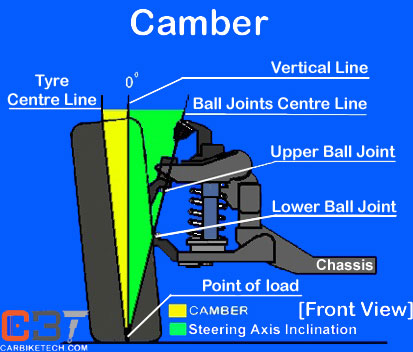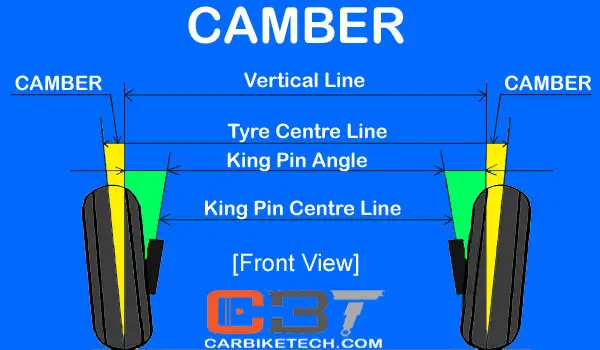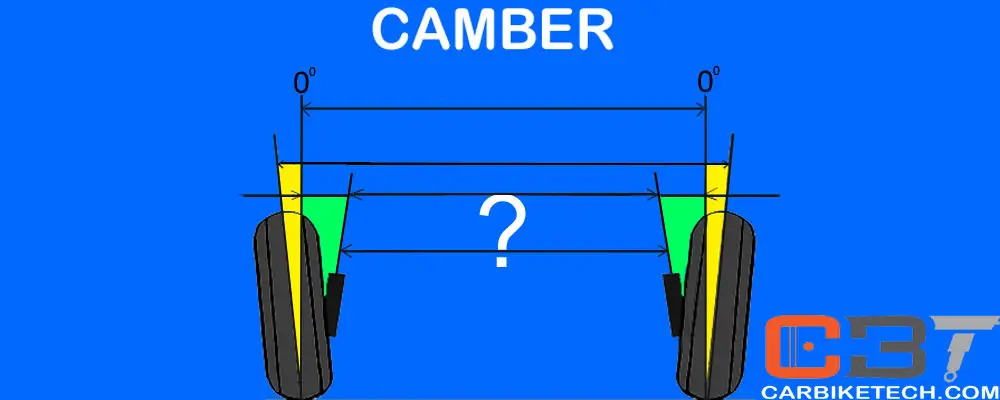What Is Camber Angle?
Basically, it is the angle which the wheels of a vehicle make with the vertical axis as seen from the front of the vehicle. Camber angle could be either positive or negative depending on the design of the chassis and suspension system. The angle made by the vehicle’s wheels against the vertical axis is called Camber. Camber is positive (+) when the top of the wheel leans outwards (away from the car) while it is negative (-) when it leans inwards (towards the car) at the top.


Besides, the front wheels are not absolutely parallel to each other but slightly tilt outwards at the top (positive camber). Usually, you can find this angle in almost every car. The main purpose of camber is to prevent the top of the wheels from tilting inwards too much which is because of the load or play in the suspension ball-joints & wheel bearing.
Effects of Camber:
Furthermore, positive camber affects the maneuverability of the vehicle around corners. It also affects the cornering ability of the vehicle. The term ‘camber’ also applies to the road surface which is known as the ‘Road Camber’. Adverse camber on the slope can throw off a vehicle from its direction while cornering. Camber angle of the vehicle’s wheels depends on variations to the suspension design. The manufacturers design the suspension systems in such a way so to get better maneuverability. Typically, the rear-wheel-drive (RWD) cars use positive camber.

Some modern cars use a slightly negative camber to improve grip while cornering and better maneuverability. It is typically used especially in front-wheel-driven cars. Due to

It has an incredible effect on the grip of the tires of the vehicle. The wheels of the vehicle generate the highest grip when they are on near vertical axis against the road or slightly inwards. Some modern cars have a slightly negative camber and align with the independently sprung suspension.
Adjustment:
The unequal camber of the wheels causes the vehicle to roll in the direction of the wheel having the greater value. It also affects the directional stability of the vehicle and tends to unevenly wear out the opposite side tire. Excessive camber causes the tires to have incorrect contact with the road.
It causes them to wear on the side directly under the load. In modern vehicles, manufacturers provide either an eccentric cam in the control arm shaft or shims to adjust the camber. Hence, it is important to carry out the wheel-alignment regularly which includes adjusting camber to manufacturer’s specifications.
King-pin inclination:
Furthermore, manufacturers mount kingpins (rigid front suspension) & ball joints (independent front suspension). They slant inwards as seen from the front of the vehicle. The center-line of kingpin or ball joints forms an angle with the vertical axis. It is known as the kingpin inclination or the steering axis inclination. King-pin/ball joints (along with caster) provide directional stability in vehicles. Because the kingpin or ball-joints

In this way, the weight of the vehicle helps to keep the front wheels pointed forward. It also exerts a force that automatically straightens the wheels after turning the steering wheel. In modern vehicles, the steering axis inclination is from 4 to 8 degrees. Apparently, if this angle is greater on one side than the other, the vehicle will tend to pull to the side with a greater angle. Also, if the angles are too large, steering will become extremely difficult to operate. The combined angle of camber and kingpin inclination is known as ‘included angle’.
Watch Camber in action here:
Read More: What is Cornering Brake Control in cars?>>
